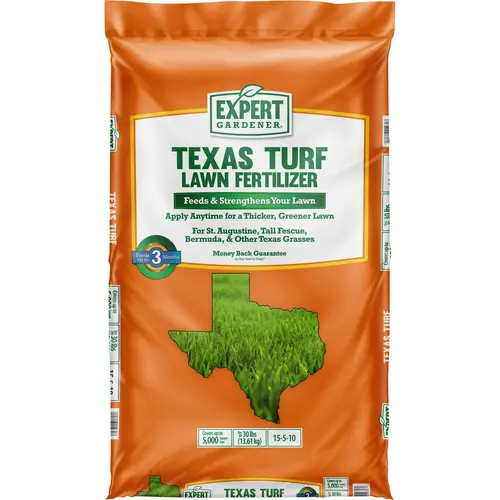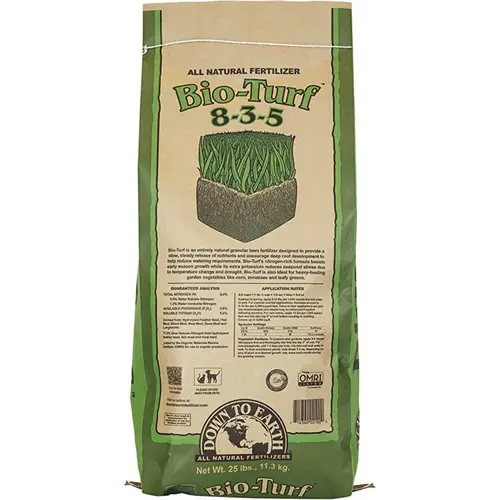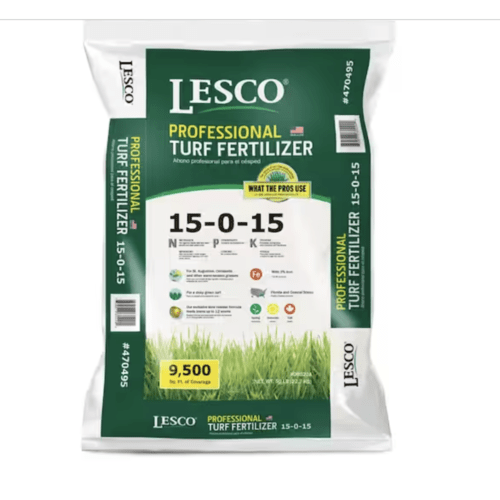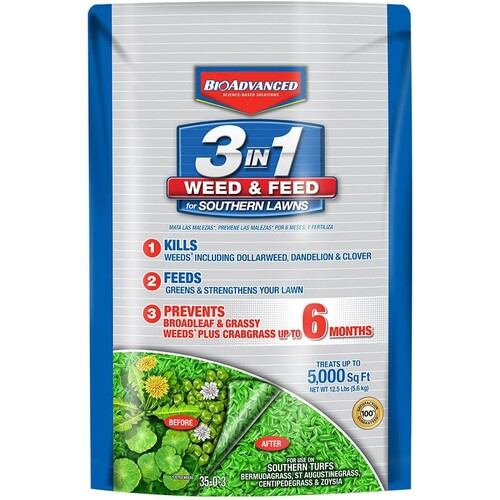
Southern homeowners covet St. Augustine’s dense growth and vibrant color. But it needs a good diet to thrive. So, we searched Home Depot, Lowe’s, Amazon, and Walmart to find the best fertilizers for St. Augustinegrass.
We compared each product’s nutrition, organic matter, and price to find the best lawn food for each season. Since soil needs vary, our article helps you find the fertilizer best suited for your lawn. We review the top St. Augustine fertilizers and provide a handy fertilizer buying guide.
Our Top Picks
Top 7 Fertilizers for St. Augustinegrass – Reviews
1. Expert Gardener Texas Turf Lawn Food – Best Spring Fertilizer

If you want a lush St. Augustine lawn this spring, we recommend Texas Turf Lawn Food. It gives your grass the nutrients it needs to flourish. Most experts (including Texas A&M and NCSU) recommend a 3-1-2 NPK ratio for St. Augustine in the spring. That’s precisely what this lawn food provides.
Its slow-release nitrogen (plus 2% iron) promotes dense, deep green growth without burning the grass. The formula fortifies your lawn’s defenses against pests, weather, and diseases. It also stimulates hardy root growth. It has everything St. Augustine needs to recover from the winter and quickly green in the spring.
Specifications
- Coverage area: 5,000 sq. ft.
- Effective period: 3 months
- Fertilizer type: Granular
- N-P-K: 15-5-10
- Package size: 30.2 lbs.
- Time release: Slow
Pros and Cons
| What we liked | What we didn’t like |
| ✓ Deepens color ✓ Thickens grass ✓ Boosts health and resilience ✓ Stimulates roots ✓ Long-lasting formula ✓ Expert-endorsed NPK | ✗ Excess phosphate can harm sea creatures ✗ Doesn’t contain organic material |
Where to buy
2. Down to Earth Organic Bio-Turf 8-3-5 – Best Organic Spring Fertilizer

Synthetic fertilizers work well periodically, but an organic formula is best for long-term soil quality. After carefully comparing the competition, we found that Down to Earth Organic Bio-Turf 8-3-5 is the best organic spring fertilizer for St. Augustinegrass. It has a nutrient-rich formula that’s OMRI-listed for organic use and CDFA-registered.
Its natural slow-release ingredients are well-balanced to sustain spring soil without burning your grass. The formula accelerates growth and improves overall health. It also helps roots take in more food and water. As a result, St. Augustine lawns defeat common spring threats such as chinch bugs and large patch.
Specifications
- Coverage area: 3,000 sq. ft.
- Effective period: 8 weeks
- Fertilizer type: Granular
- N-P-K: 8-3-5
- Package size: 25 lbs.
- Time release: Slow
Pros and Cons
| What we liked | What we didn’t like |
| ✓ Organic ✓ Safe for children and pets ✓ Speeds up growth ✓ Boosts health and resilience ✓ Stimulates roots ✓ Improves long-term soil quality ✓ Can also feed nitrogen-hungry vegetables | ✗ Excess phosphate can harm sea creatures ✗ Expensive |
Where to buy
3. Espoma Organic All-Season Lawn Food – Best Summer Fertilizer

St. Augustine needs a lot of nitrogen to thrive through its summer growth spurt. Nitrogen is typically the only nutrient that clay and loam soils lack in the summer. Our favorite source of summer nitrogen for St. Augustinegrass is Espoma Organic All-Season Lawn Food.
Its natural formula is great for your grass and the long-term sustainability of your soil. It promotes dense growth and vibrant color. The organic lawn food contains no sludges or fillers, is safe for children and pets, and won’t burn your grass. Additionally, Espoma is an eco-conscious company that makes this fertilizer at a solar-powered plant.
Specifications
- Coverage area: 5,000 sq. ft.
- Effective period: 3 months
- Fertilizer type: Granular
- N-P-K: 9-0-0
- Package size: 28 lbs.
- Time release: Slow
Pros and Cons
| What we liked | What we didn’t like |
| ✓ Organic ✓ Thickens grass ✓ Deepens color ✓ Safe for children and pets ✓ Contains beneficial microbes | ✗ Not good for potassium deficient soil ✗ Not good for phosphorus deficient soil |
Where to buy
4. Lesco 15-0-15 – Best Summer Fertilizer with Potash

Sandy soil seldomly has enough potassium to sustain grass in the summer and even some loams need summer potash. We recommend Lesco 15-0-15. In addition to improving grass’s thickness and color, it enhances your lawn’s vitality and resilience. Its nutrients give St. Augustine the strength needed to defeat summer pests and thrive through seasonal changes.
Landscaping pros trust Lesco to give sandy soil a summer boost. The professional-grade formula gradually releases nutrients, feeding your lawn for up to 12 weeks.
Specifications
- Coverage area: 9.500 sq. ft.
- Effective period: 12 weeks
- Fertilizer type: Granular
- N-P-K: 15-0-15
- Package size: 50 lbs.
- Time release: Slow
Pros and Cons
| What we liked | What we didn’t like |
| ✓ Thickens grass ✓ Deepens color ✓ Boosts health and resilience ✓ Great for potassium-deficient soil ✓ Long-lasting formula | ✗ Not good for phosphorus deficient soil ✗ Not good for potassium-rich soil |
Where to buy
5. Jonathan Green Winter Survival Fall Fertilizer – Best Fall Fertilizer

Sometimes St. Augustine has trouble weathering the winter. Give your grass the best shot at survival by feeding it a potassium-rich, slow-release, fall fertilizer. Fall soil typically needs about twice as much potassium as nitrogen and that’s exactly what Jonathan Green’s Fall Fertilizer provides. It boosts grass’s immune system and improves its all-around health.
Too much nitrogen (or not enough potassium) makes it easier for St. Augustine to get sick. Lawn diseases, such as large patch, are often preventable by providing a proper diet. Jonathan Green’s fertilizer slowly releases a little bit of nitrogen and a lot of potassium, feeding lawns up to three months.
It helps St. Augustine:
- Quickly recover from summer damage (i.e., severe droughts and heat waves)
- Thrive through the fall
- Build strength to survive the winter
As a result, your grass will quickly turn green in the spring.
Specifications
- Coverage area: 15,000 sq. ft.
- Effective period: 3 months
- Fertilizer type: Granular
- N-P-K: 10-0-20
- Package size: 45 lbs.
- Time release: Slow release
Pros and Cons
| What we liked | What we didn’t like |
| ✓ Boosts immune system ✓ Speeds up recovery ✓ Strengthens grass for winter survival ✓ Speeds up spring green up ✓ Long-lasting formula | ✗ Not good for phosphorus deficient soil |
Where to buy
6. Simple Lawn Solutions Advanced 16-4-8 – Best Liquid Fertilizer

The best liquid fertilizer for St. Augustine is Simple Lawn Solutions Advanced 16-4-8. It provides balanced spring nutrition in a fast-release formula. You can see grass green up in as little as a couple of days. It continues to invigorate your lawn for about two weeks. The feed-grade ingredients add organic matter to the soil, encouraging healthy root development.
As a bonus, it’s super simple to apply. The fertilizer comes in a ready-to-use spray bottle that attaches to your garden hose. You can fertilize and water your lawn at the same without creating a mess.
Specifications
- Coverage area: 12,800 sq. ft.
- Effective period: 2 weeks
- Fertilizer type: Liquid
- N-P-K: 16-4-8
- Package size: 1 gallon
- Time release: Quick
Pros and Cons
| What we liked | What we didn’t like |
| ✓ Deepens color ✓ Thickens grass ✓ Boosts health and resilience ✓ Stimulates roots ✓ Adds organic matter to the soil ✓ Fast acting ✓ Easy to apply | ✗ Excess phosphate can harm sea creatures ✗ Doesn’t feed as long as granules ✗ Liquid fertilizer is more likely to cause fertilizer burn |
Where to buy
7. BioAdvanced 3-in-1 for Southern Lawns – Best Weed and Feed

The best weed and feed for St. Augustinegrass is BioAdvanced 3-in-1 for Southern Lawns. In addition to feeding lawns, it contains pre-emergent and post-emergent herbicides. In one application, BioAdvanced 3-in-1:
- Nourishes grass, inspiring vibrant growth
- Kills visible lawn weeds, including dollarweed and nutsedge
- Prevents broadleaf and grassy weeds, including crabgrass
Crabgrass is one of St. Augustine’s most common weedy culprits, and many crabgrass-control products are harmful to St. Augustine. BioAdvanced 3-in-1 Weed and Feed only contains St. Augustine-safe herbicides. The long-lasting formula fertilizes for up to eight weeks and prevents weeds for up to six months.
Specifications
- Coverage area: 10,000 sq. ft.
- Effective period: 8 weeks
- Fertilizer type: Granular
- Herbicides: Pre and post emergent
- N-P-K: 35-0-3
- Package size: 25 lbs.
- Time release: Slow
Pros and Cons
| What we liked | What we didn’t like |
| ✓ Deepens color ✓ Thickens grass ✓ Increases vitality ✓ Kills and prevents lawn weeds | ✗ Not good for potassium deficient soil ✗ Not good for phosphorus deficient soil ✗ Prolonged use is bad for the soil |
Where to buy
Buyer’s Guide
To find the best grass fertilizer for your St. Augustine lawn, consider the following:
NPK
The NPK ratio is the most crucial fertilizer factor. It shows you what percentage of N, P, and K your fertilizer contains. These are the three most essential plant nutrients, also known as macronutrients:
- Nitrogen (N) is the first number in the NPK ratio. It encourages grass to grow faster, thicker, and greener. Grass needs a lot of N, so this is typically the highest number in the ratio.
- Phosphorus (P) supports your grass’s root system. New lawns need plenty of P to form strong roots, but established lawns only need a little. Some states have banned phosphate fertilizers because they’re dangerous to sea life when excessive amounts infiltrate runoff water. But no southern states have such a ban.
- Potassium (K) promotes overall good health. It makes grass more resistant to weather, pests, and diseases. For more information, check out our article: “What Does Potassium Do for Your Lawn?”
Calculating NPK
Example: Say, you buy a bag of fertilizer with the following specs:
- NPK ratio: 15-5-10
- Weight: 20 pounds
What percentage of NPK does the fertilizer contain? 15% of the fertilizer is nitrogen, 5% is phosphorous, and 10% is potassium.
How many pounds of Nitrogen (N) are in the bag? Multiple 15% by 20 pounds to find the total amount of N.
.15 x 20 pounds=3 pounds of N
Comparing Ratios
Ratios are equal when they contain the same proportion. We reduce ratios down to their simplest form to compare them. For example, 1/2 (one-half) is the same ratio as 2/4, 4/8, or 50/100.
If you’re looking for a 3-1-2 NPK ratio, you can choose any fertilizer with an equivalent proportion. 6-2-4, 9-3-6, and 15-5-10 fertilizers all have a 3-1-2 NPK ratio.
Micronutrients
In addition to NPK, lawns need micronutrients. Although grass only needs a little bit of these secondary nutrients, deficiencies cause distress. For example:
- Copper (Cu): A copper deficit stunts blade and root growth.
- Iron (Fe): A lack of iron (aka iron chlorosis) turns turf light green or yellow.
- Manganese (MN): Low levels decrease the effectiveness of photosynthesis. Grass’s overall health declines and blades often turn yellow.
- Zinc (Zn): Soil short on Zinc can stunt grass growth and cause discoloration.
Most soil already has enough of these to sustain grass, so you should get a soil test before supplementing the soil. Sandy soil is more likely to need these nutrients than loam or clay.
Soil Test
Soil nutrients vary depending on soil type, location, and cultural practices. To best fertilize St. Augustinegrass, get a soil test. It will show you the soil’s level of:
- NPK
- Micronutrients
- Organic matter
- pH
You can get a soil test from your local university extension by mailing them a soil sample. Find your university extension through the National Institute of Food and Agriculture’s online directory.
St. Augustinegrass’s Needs
Each grass type has its own personality. The best fertilizers for St. Augustine differ from the best for Bermudagrass or centipede. Keep your St. Augustinegrass lawn healthy and lush by knowing what it needs to thrive:
- About St. Augustine
- Yearly NPK Schedule
- Spring/Summer Fertilization
- Fall Fertilization
- Soil pH
- General Lawn Care
About St. Augustine
St Augustinegrass is a warm-season grass that’s popular in southern states. It’s most common in coastal areas because it’s very salt tolerant. St. Augustine is known for its rich blue-green color, coarse blades, and fast growth rate.
It’s the most shade-tolerant warm-season turfgrass and typically retains its color during moderate droughts. Due to its density, St. Augustine outcompetes many weeds. However, it needs frequent mowing and is susceptible to pests and diseases. Common threats include chinch bugs, armyworms, grubs, brown patch, gray leaf spot, and fairy ring.
Yearly NPK Schedule
Check the chart below to see St. Augustine’s fertilization schedule. Your lawn shouldn’t get more than 5 pounds of nitrogen per 1,000 square feet annually.
| Season | NPK |
| Spring | Complete fertilizer with NPK ratioof around 3-1-2 |
| Summer | High nitrogen fertilizer, such as 21-0-0 or 15-0-15 |
| Early Fall | Low nitrogen and high potassium, such as 5-10-10 |
Tropical Climates: If you live in a tropical climate, like South Florida, St. Augustine never goes dormant. It grows year-round. Thus, nitrogen fertilizer may be applied in any season. However, it usually requires a lower application rate in the winter.
Spring/Summer Fertilization
The amount of fertilizer needed depends on the state of your soil. But in general, St. Augustine lawns should get 1 to 1 ½ pounds of nitrogen per 1,000 square feet every eight to 10 weeks during the growing season (spring and summer).
- First Fertilization: Start spring fertilization after the last expected frost and about three weeks after the grass greens up. For most homeowners, that’s in March or April.
- March – May: A balanced diet, such as a 3-1-2 fertilizer, best feeds most St. Augustine lawns until eight to 10 weeks after the first feeding.
- June – July: St. Augustine needs a lot of nitrogen in the summer. It doesn’t need phosphorus, but an early summer helping of potassium suits some soil. Most sandy soils need something similar to a 15-0-15 fertilizer, but clay lawns typically prefer something more like 21-0-0.
- August – September: St. Augustine continues to need a nitrogen-rich diet but is more likely to need potassium during the last month of summer.
Fall Fertilization
St. Augustine’s growth slows in the fall as it prepares to enter winter dormancy. Fall feedings should contain no more than ½ pound of nitrogen per 1,000 square feet of lawn.
Early Fall: Around September (four to six weeks before temperatures drop below 55° F) apply a low-nitrogen, high-potassium fertilizer. Some soil also needs a hearty helping of phosphorus.
Soil pH
St. Augustine thrives with a soil pH level of 6.0 to 7.5. Apply sulfur to lower your soil’s pH or raise it by adding agricultural lime.
General Lawn Care
Fertilizing your lawn with one of the best fertilizers for St. Augustinegrass will boost its vitality. But proper fertilization is only one piece of the puzzle. If you want a lush lawn year after year, follow these St. Augustinegrass maintenance tips from Texas A&M University:
- Keep your grass tall. It’s best to mow at 2½ to 3 inches in the sun or 3 to 3½ inches in the shade.
- Wait to water the lawn until your grass shows signs of drought stress, including fading color or folded leaves (usually once every five to 10 days, depending on the weather).
- Select weed control products carefully because St. Augustinegrass is sensitive to some herbicides, including 2,4-D, MCPP, MSMA, and dicamba.
- Watch for signs of common St. Augustine pests, such as chinch bugs and white grubs.
- Improve water and nutrient flow by dethatching the lawn in April or May if the thatch layer has become thicker than ¾ inch.
- Prevent compacted soil by aerating the lawn during St. Augustine’s growing season of late spring and summer.
Types of Fertilizer
There are different types of fertilizers, including:
- Liquid vs. granular: Liquid fertilizers are applied with a sprayer. They typically act faster but don’t feed as long as granular fertilizers. Granules, which you apply using a fertilizer spreader, might make you wait a little longer for green-up, but the results will last longer. Thus, granules require fewer fertilizer applications.
- Slow-release vs. quick-release: Slow-release fertilizers gradually emit nutrients over several weeks. In contrast, quick-release fertilizers emit all their nutrients instantaneously. You’ll need to apply quick-release lawn food more often, and there’s a higher chance of fertilizer burn. But quick-release products yield faster results.
- Organic: Organic lawn fertilization costs more than synthetics but is better for the soil. Organic matter improves your soil’s structure by increasing the number of beneficial microorganisms. Additionally, organic fertilizers are eco-friendly and safe around pets and children.
- Lawn starters: Lawn starter fertilizers are for newly seeded or sodded lawns. They contain a nutrient blend that’s gentle on the new grass and helps it get established quickly.
- Weed and feed: Fertilizer mixed with herbicide is called weed and feed. One application greens up grass and controls lawn weeds. Pre-emergent herbicides prevent weeds, and post-emergent herbicides kill existing ones. Some weed and feeds contain both. But be careful. Most products that kill grassy weeds, like crabgrass, also kill St. Augustinegrass.
- Other add-ons: Some fertilizers contain fungicides for disease prevention or pesticides for insect control.
Price of Fertilizer
A package of lawn fertilizer typically costs $25 to $70 and covers 2,500 to 10,500 square feet. However, the cost varies depending on the type of fertilizer.
| Average Cost of Fertilizer | $45 |
| Typical Price Range | $25 – $70 |
| Extreme Low | $8 |
| Extreme High | $100 |
Organic vs. Synthetic Fertilizer: An average fertilizer package costs about $45, whether it’s organic or synthetic. But organic fertilizer packages typically contain less product, making fertilization more costly. This is illustrated in the table below.
| Organic | Synthetic | |
| Average Cost | $45 | $45 |
| Typical Price Range | $30 – $65 | $25 – $70 |
| Average Cost / 1,000 sq. ft. | $17 | $12 |
Liquid vs. Granular Fertilizer: A package of liquid lawn food typically costs less than a package of granules but covers much less ground. Liquid fertilization is more expensive per square foot of lawn, as shown in the table below.
| Liquid | Granular | |
| Average Cost | $30 | $50 |
| Typical Price Range | $20 – $45 | $25 – $70 |
| Typical Cost / 1,000 sq. ft. | $6 – $20 | $5 – $10 |
FAQ about Fertilizing St. Augustinegrass
How Do I Make My St. Augustine Lawn Thicker?
If you want your grass to grow thicker, encourage it to spread to fill in thin and patchy areas.
Here are some tips to get St. Augustinegrass to spread faster:
- Apply nitrogen-rich fertilizer with phosphorus for root growth during the growing season (late spring and summer)
- Water your lawn more often than usual in summer
- Mow your lawn less frequently, usually once weekly in summer
What’s the Best Fertilizer for Palmetto Grass?
“Palmetto” is one of the most popular cultivars of St. Augustinegrass. It’s naturally a more vibrant green than other varieties. Even though Palmetto grass looks a little different, its fertilization needs are the same as any other type of St. Augustine, so any of the fertilizers in our top picks will work great.
How Do I Make My Own Organic Fertilizer?
You can keep a healthy green lawn by making your own fertilizer. Common ingredients include:
- Grass Clippings
- Bone Meal
- Eggshells
- Coffee Grounds
- Compost
- Wood Ash
- Aquarium Water
When to Call a Lawn Treatment Pro
There are many things to consider when maintaining St. Augustinegrass. And once you think you’ve solved the puzzle, you still have to push a spreader across your lawn. Or do you?
LawnStarter links you to qualified local lawn treatment pros. Our pros use the best fertilizers and equipment, and they know what it takes to make St. Augustine thrive. It only takes a moment to get a free online quote. Most homeowners are shocked to see how affordable quality lawn care can be.
LawnStarter participates in the Amazon Services LLC Associates Program and other retailer affiliate programs. LawnStarter may earn revenue from products promoted in this article.
Main Image Credit: JillianCain / Canva Pro / License wih Text Overlay using Canva Pro